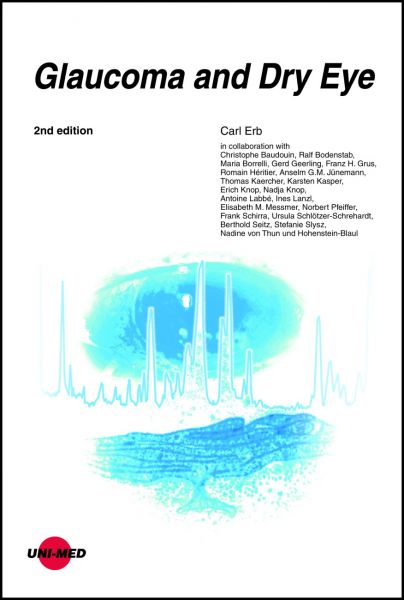Glaucoma and Dry Eye
Eight years have passed since the first English edition in 2011 and the topic of this textbook has lost none of its clinical significance. The coexistence of a dry eye can severely affect glaucoma patients in their daily lives. The associated consequence is reduced adherence in the use of antiglaucomatous eye drops, which represents a significant risk factor for the progression of glaucomatous optic neuropathy.
In this respect, this complex interplay between glaucoma disease and dry eye is very important in practical everyday life. Sometimes it is not easy to get both diseases under control. The present new edition should help to understand this problem a bit better and to provide the affected patients as optimally as possible.
1. Fluid mechanics of the tear film (R. Bodenstab) 14
1.1. Introduction 14
1.2. Model conceptions 14
1.3. Basics of numerical tear film models 15
1.4. Newtonian versus non-Newtonian fluids 16
1.5. Mucin 16
1.6. Factors influencing mucin rheology 17
1.7. Flow behavior and tribology 19
1.8. Extended model of lubrication 21
1.9. Influence of tear film on eyelid blink 22
1.10. References 24
2. Corneal nerves in glaucoma and dry eye: Contribution of in vivo confocal
microscopy (A. Labbé, R. Héritier, C. Baudouin) 28
2.1. Introduction 28
2.2. Corneal nerves and IVCM 28
2.3. Corneal nerves and dry eye disease 29
2.4. Corneal nerves in patients medically treated for glaucoma 31
2.5. Role of inflammation in corneal nerve alterations in dry eye disease and glaucoma 32
2.6. Conclusion 32
2.7. References 32
3. A clinical overview of dry eye (T. Kaercher) 36
3.1. The dry eye 37
3.2. The wet eye 40
3.3. The inflamed eye 41
3.4. References 43
4. Investigation of dry eye (F. Schirra, B. Seitz) 46
4.1. Introduction 46
4.2. History 46
4.3. Findings 46
4.3.1. Lid parallel conjunctival folds (LIPCOF) 46
4.3.2. Meibomian gland dysfunction 48
4.4. Diagnostic tests 49
4.4.1. Notes on diagnostic tests 49
4.4.2. Measurement of tear volume 49
4.4.2.1. Schirmer’s test 49
4.4.2.2. Other tests of volume 52
4.4.3. Measurement of tear film stability 52
4.4.4. Integrity of the ocular surface 54
4.4.4.1. Fluorescein test 54
4.4.4.2. Rose Bengal test 55
4.4.5. Measurement of the osmolarity of tear fluid 56
4.5. References 56
5. Eye-Associated Lymphoid Tissue (EALT) and its relationship to sicca
syndrome (E. Knop, N. Knop) 60
5.1. Overview of the dry eye 60
5.1.1. Definition 60
5.1.2. Symptoms and clinical tests 60
5.1.3. Epidemiology 60
5.1.4. The eye´s mucosal immune system is protective – but if deregulated can promote inflammation
in dry eye disease 60
5.2. Anatomy of the ocular surface and mucosal immune system 61
5.2.1. Structure of the ocular surface and tear film 61
5.2.2. Mucosal immune system of the ocular surface 62
5.2.2.1. Components of the mucosal immune system 62
5.2.2.2. The mucosal immune system of the ocular surface forms continuous eye-associated lymphoid
tissue (EALT) 65
5.3. Influence of the mucosal immune system on dry eye 65
5.3.1. The normal function of EALT is protective 66
5.3.2. Deregulation of the mucosal immune system through chronic surface irritation in dry eye can
lead to the loss of immune tolerance 66
5.3.3. The loss of immune tolerance leads to chronic progressive immune-modulated inflammation
with destruction of the ocular surface 68
5.4. References 69
6. The importance of autoimmune processes in sicca syndrome and glaucoma
(F. Grus) 78
6.1. Introduction 78
6.2. Autoimmune processes in glaucoma 78
6.3. Sicca syndrome: analysis of tear fluid 79
6.4. Can glaucoma and sicca syndrome now be described as autoimmune diseases? 81
6.5. Natural autoimmunity 82
6.6. References 84
7. Preservatives and their relevance for the ocular surface (G. Geerling,
M. Borrelli, K. Kasper) 88
7.1. Background 88
7.2. Why are ophthalmics preserved? 88
7.3. Common preservatives 89
7.3.1. Quaternary ammonium compounds 89
7.3.2. Mercury compounds 90
7.3.3. Alcohols 90
7.3.4. Sorbic acid 90
7.3.5. EDTA 91
7.3.6. Oxychloro complex 91
7.4. Problems with the use of preservatives 91
7.5. Preservative-free container forms 92
7.5.1. Single-dose drop containers 92
7.5.2. Bottles with innovative valve/pump technologies 94
7.5.3. Microfilter system 95
7.6. When should preservative-free artificial tears and antiglaucoma products be used? 95
7.7. Costs 95
7.8. Individual therapy, compliance and freedom for medical treatment 96
7.9. References 96
8. Results of the German Register for Glaucoma Patients with Dry Eye (C. Erb) 100
8.1. Introduction 100
8.2. Prevalence of concomitant diseases 100
8.3. Gender and age differences 100
8.4. Effect of anti-glaucoma agents and duration of glaucoma disease on the prevalence of
dry eye 100
8.5. Benzalkonium chloride/anti-glaucoma active substances as cofactors for dry eye in
glaucoma patients 101
8.6. Ways to improve compliance in glaucoma patients 101
8.7. References 102
9. PEX glaucoma as a model of glaucoma with sicca symptoms
(U. Schlötzer-Schrehardt, A. Jünemann) 106
9.1. Background 106
9.2. Involvement of the conjunctiva in the PEX process 106
9.3. Tear function in PEX syndrome/glaucoma 107
9.4. Composition of tear fluid in PEX syndrome/glaucoma 109
9.5. Dry eye in PEX syndrome/glaucoma 109
9.6. References 110
10. Importance and availability of preservative-free eye drops (E. M. Messmer) 114
10.1. Tolerability 115
10.2. Adherence and persistence 115
10.3. Success of glaucoma filtering surgery 116
10.4. Alternatives to benzalkonium chloride 116
10.5. References 117
11. Compliance in glaucoma patients (I. Lanzl) 122
11.1. Introduction 122
11.2. The different types of non-compliance 122
11.3. Current studies 123
11.4. Reasons for non-compliance 124
11.5. Possibilities for improving compliance 124
11.6. References 125
Index 127
DE
Versandkostenfreie Lieferung! (eBook-Download)
Als Sofort-Download verfügbar
- Artikel-Nr.: SW9783837464054458270
- Artikelnummer SW9783837464054458270
-
Autor
Carl Erb
- Wasserzeichen ja
- Verlag UNI-MED Verlag AG
- Seitenzahl 129
- Veröffentlichung 24.01.2020
- ISBN 9783837464054
- Wasserzeichen ja

